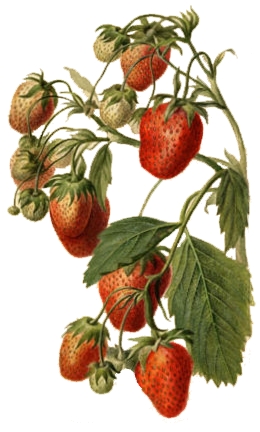Outline of strawberries
Outline of Strawberries
Strawberries are a widely beloved fruit known for their bright red color, juicy texture, and sweet flavor. This outline provides a comprehensive overview of all aspects related to strawberries, including their botany, cultivation, nutritional value, and cultural significance.
Botany[edit | edit source]
Strawberries belong to the genus Fragaria, within the family Rosaceae. Unlike most fruits, strawberries wear their seeds on the outside, with each seed actually being considered a separate fruit technically known as an achene. The part of the strawberry we commonly consume is an enlarged receptacle, not a true fruit in the botanical sense.
Species[edit | edit source]
There are several species of strawberries, with the most commonly cultivated being the garden strawberry (Fragaria × ananassa). This species is a hybrid, originally developed in the 18th century through the crossing of Fragaria virginiana (from North America) and Fragaria chiloensis (from South America).
Cultivation[edit | edit source]
Strawberry plants are grown worldwide, with varying methods depending on the climate and geography. They can be grown from seed, but more commonly, they are propagated through runners, which are horizontal stems that produce new plants at the nodes.
Growing Conditions[edit | edit source]
Strawberries thrive in temperate climates and require well-drained, loamy soil with a pH between 5.5 and 6.8. They need full sunlight for optimal growth and fruit production.
Pests and Diseases[edit | edit source]
Strawberries are susceptible to a range of pests and diseases, including fungal diseases like powdery mildew and pests such as the strawberry aphid. Integrated pest management strategies are commonly employed to minimize damage.
Nutritional Value[edit | edit source]
Strawberries are a rich source of Vitamin C, manganese, folate, and potassium. They are also high in antioxidants and plant compounds, which contribute to heart health and blood sugar control.
Culinary Uses[edit | edit source]
Strawberries are versatile in culinary applications, used in everything from fresh salads and desserts to preserves and beverages. Their sweet flavor pairs well with a variety of ingredients, including balsamic vinegar, chocolate, and dairy products.
Cultural Significance[edit | edit source]
Strawberries have a rich history and are celebrated in festivals and events worldwide. They have been depicted in art and literature for centuries, symbolizing spring, fertility, and purity in various cultures.
Conservation[edit | edit source]
With the increasing demand for strawberries, conservation efforts focus on sustainable cultivation practices to protect biodiversity, reduce environmental impact, and ensure the fruit's availability for future generations.
Navigation: Wellness - Encyclopedia - Health topics - Disease Index - Drugs - World Directory - Gray's Anatomy - Keto diet - Recipes
Search WikiMD
Ad.Tired of being Overweight? Try W8MD's physician weight loss program.
Semaglutide (Ozempic / Wegovy and Tirzepatide (Mounjaro) available.
Advertise on WikiMD
WikiMD is not a substitute for professional medical advice. See full disclaimer.
Credits:Most images are courtesy of Wikimedia commons, and templates Wikipedia, licensed under CC BY SA or similar.
Contributors: Prab R. Tumpati, MD

